Sharif of Mecca
The Sharif of Mecca (Arabic: شريف مكة, Sharīf Makkah) or Hejaz (Arabic: شريف الحجاز, Sharīf al-Ḥijāz) was the title of the leader of the Sharifate of Mecca, traditional steward of the holy cities of Mecca and Medina and the surrounding Hejaz. The term sharif is Arabic for "noble", "highborn", and is used to describe the descendants of Prophet Muhammad's grandson al-Hassan ibn Ali.
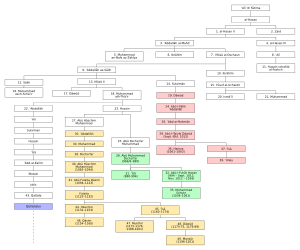
The Sharif was charged with protecting the cities and their environs and ensuring the safety of pilgrims performing the Hajj. The title is sometimes spelled Sheriff or Sherif, with the latter variant used, for example, by T. E. Lawrence in Seven Pillars of Wisdom.
The office of the Sharifate of Mecca dates back to the late Abbasid era. Until 1200, the Sharifate was held by a member of the Hawashim clan,[1][2] not to be confused with the larger clan of Banu Hashim from which all Sharifs claim descent. Descendants of the Banu Hashim continued to hold the position until the 20th century on behalf of various Muslim powers including the Ayyubids and the Mamluks. In 1517, the Sharif acknowledged the supremacy of the Ottoman Caliph, but maintained a great degree of local autonomy. During the Ottoman era, the Sharifate expanded its authority northwards to include Medina, and southwards to the frontiers of 'Asir, and regularly raided Nejd.
The Sharifate came to an end shortly after the reign of Hussein bin Ali, who ruled from 1908, who rebelled against the Ottoman rule during the Arab Revolt of 1916. After the defeat of the Ottoman Empire in 1918 and its subsequent dissolution in 1923, Hussein declared himself Caliph. The British granted control over the newly formed states of Iraq and Transjordan to his sons Faisal and Abdullah. In 1924, however, in the face of increasing attacks by Ibn Saud, Hussein abdicated his secular titles to his eldest son, Ali bin Hussein, who was to become the last Grand Sharif. At the end of 1925, Ibn Saud conquered the Hejaz and expelled the Hashemites. The House of Saud has ruled the holy cities and overseen the Hajj since that time.[3]
List of Sharifs of Mecca (967–1925)
During the Fatimid Dynasty (967–1101)
| Emir | Reign | Notes |
|---|---|---|
| Ja'farid dynasty | ||
| Ja'far ibn Muhammad al-Hasani | 967–980 | |
| Isa ibn Ja'far | 980–994 | |
| Abu'l-Futuh al-Hasan ibn Ja'far | 994–1012 | Briefly anti-Caliph in 1012 |
| Abu Tayeb Daoud bin Abdul Rahman bin Abi Al-Fatik | 1012–1039 | |
| Shukr ibn Abi'l-Futuh | 1039–1061 | Died childless, end of the Ja'farid dynasty |
| Hawashim dynasty | ||
| Abu Hashim Muhammad ibn Ja'far | 1062–1094 | |
| Ibn Abu'l-Hashim al-Thalab | 1094–1101 | |
During the Ayyubid Empire (1201–1254)
| Emir | Reign | Notes |
|---|---|---|
| Qatada ibn Idris al-Hasani al-Alawi | 1201–1220 | Killed at age 90 by his son; founder of the Banu Qatada, the dynasty which ruled Mecca until 1925. |
| Hasan ibn Qatada al-Hasani al-Alawi | 1220–1241 | Al-Zahir Baibers ruler of Egypt sends a prince to collect Zakat from the area including the surrounding bedouins |
| Al-Hassan abul-Saad | 1241–1254 |
1250–1301
| Emir | Reign AH | Reign CE | Notes | References |
|---|---|---|---|---|
| Abu Sa'd Hasan ibn Ali ibn Qatadah | 647–651 | 1250–1253 | Reigned until his death. Killed by Jammaz ibn Hasan. | [4] |
| Abu Numayy Muhammad ibn Abi Sa'd | ?–651 | ?–1253 | Co-reigned with his father. Named co-ruler after he defended Mecca from capture by Rajih ibn Qatadah and his Banu Husayn allies. | [5] |
| Jammaz ibn Hasan ibn Qatadah | 651 – Hij 651 | 1253 – Feb 1254 | Captured Mecca with an army provided by al-Nasir Yusuf, the Ayyubid ruler of Syria, to whom he had promised the khutbah. However, he reneged and continued the khutbah in the name of al-Muzaffar Yusuf, the Rasulid sultan of Yemen. Deposed by Rajih ibn Qatadah. | [6] |
| Rajih ibn Qatadah | Hij 651 – Rb1 652 | Feb 1254 – Apr/May 1254 | Deposed by his son Ghanim. | [7] |
| Ghanim ibn Rajih | Rb1 652 – Shw 652 | Apr/May 1254 – Nov/Dec 1254 | Deposed by Abu Numayy and Idris. | [8] |
| Abu Numayy Muhammad ibn Abi Sa'd | Shw 652 – Qid 652 | Nov/Dec 1254 – Jan 1255 | Co-rulers. Khutbah in the name of al-Ashraf Musa, the titular Ayyubid sultan of Egypt, and his atabeg al-Mu'izz Aybak. Deposed by the Yemeni emir Ibn Birtas. | [9] |
| Idris ibn Qatadah | ||||
| Rasulid occupation | [10] | |||
| Husayn ibn Ali ibn Birtas Mubariz al-Din |
Qid 652 – Muh 653 | Jan 1255 – Mar 1255 | Yemeni emir. Reigned on behalf of the Rasulid sultan al-Muzaffar Yusuf. | |
| Idris ibn Qatadah | Muh 653 – 654 | Mar 1255 – 1256 | Co-reigned with his nephew. Deposed in absentia by Abu Numayy when he left Mecca to visit his brother Rajih ibn Qatadah. | [11] |
| Abu Numayy Muhammad ibn Abi Sa'd | Muh 653 – 656 | Mar 1255 –1258 | Co-reigned with his uncle for most of his reign. | |
| Idris ibn Qatadah | 654–656 | 1256–1258 | Restored as co-ruler. | |
| Sons of Hasan ibn Qatadah | 656 | 1258 | Took over Mecca while Abu Numayy was absent. Imprisoned Idris and held the city for six days, then withdrew when Abu Numayy returned. | [12] |
| Idris ibn Qatadah | 656–667 | 1258 – 1268/1269 | Co-reigned with his nephew. Deposed for his pro-Rasulid inclinations when Abu Numayy sought the favor of the Egyptian Mamluks. | [13] |
| Abu Numayy Muhammad ibn Abi Sa'd Najm al-Din |
656 – Rb1 669 | 1258 – Oct/Nov 1270 | Co-reigned with his uncle for most of his reign. In 667 AH he instituted the khutbah in the name of the Mamluk sultan al-Zahir Baybars. Deposed by Idris. | |
| Idris ibn Qatadah Baha’ al-Din |
667 – Rb2/Jm1 669 | 1268/1269 – Nov/Dec 1270 | Restored as co-ruler and pledged obedience to the Mamluk sultan. Co-reigned with his nephew until Rabi I 669 AH, then reigned independently for 40 days. Beheaded by Abu Numayy on the battlefield at Khulays. | |
| Abu Numayy Muhammad ibn Abi Sa'd Najm al-Din |
Rb2/Jm1 669 – Saf 670 | Nov/Dec 1270 – Sep/Oct 1271 | Deposed by Jammaz ibn Shihah and Ghanim ibn Idris. | [14] |
| Husaynid occupation | ||||
| Jammaz ibn Shihah ‘Izz al-Din |
Saf 670 – Rb2 670 | Oct 1271 – Dec 1271 | Co-rulers. Held Mecca for 40 days. Deposed by Abu Numayy. | |
| Ghanim ibn Idris ibn Hasan ibn Qatadah | ||||
| Abu Numayy Muhammad ibn Abi Sa'd Najm al-Din |
Rb2 670 – 687 | Dec 1271 – 1288/1289 | Deposed by Jammaz ibn Shihah. | [15] |
| Husaynid occupation | ||||
| Jammaz ibn Shihah ‘Izz al-Din |
687 | 1288/1289 | Emir of Medina. Captured Mecca with an army provided by the Mamluk sultan al-Mansur Qalawun, but afterwards struck coins and had the khutbah pronounced in his own name. Returned to Medina after he was poisoned. | |
| Abu Numayy Muhammad ibn Abi Sa'd Najm al-Din |
687 – Saf 701 | 1288/1289 – Oct 1301 | Reigned until his death. | [16] |
| Humaydah ibn Abi Numayy Izz al-Din |
Saf 701 – Hij 701 | Oct 1301 – Aug 1302 | ||
| Rumaythah ibn Abi Numayy Asad al-Din |
||||
| Abu al-Ghayth ibn Abi Numayy Imad al-Din |
Hij 701 – Hij 704 | Aug 1302 – Jul 1305 | ||
| Utayfah ibn Abi Numayy Sayf al-Din |
||||
| Humaydah ibn Abi Numayy Izz al-Din |
Hij 704 – c. Hij 713 | Jul 1305 – c. Mar 1314 | ||
| Rumaythah ibn Abi Numayy Asad al-Din |
||||
| Abu al-Ghayth ibn Abi Numayy Imad al-Din |
c. Hij 713 – c. Saf 714 | c. Mar 1314 – c. Jun 1314 | ||
| Humaydah ibn Abi Numayy Izz al-Din |
c. Saf 714 – Ram 715 | c. Mar 1314 – Dec 1315 | ||
| Rumaythah ibn Abi Numayy Asad al-Din |
Ram 715 – c. Muh 718 | Dec 1315 – c. Mar 1318 | ||
| Humaydah ibn Abi Numayy Izz al-Din |
c. Muh 718 – c. Rb2 718 | c. Mar 1318 – c. Jun 1318 | ||
| Rumaythah ibn Abi Numayy Asad al-Din |
c. Rb2 718 – Hij 718 | c. Jun 1318 – Feb 1319 | ||
| Utayfah ibn Abi Numayy Sayf al-Din |
Muh 719 – c. Rb1 731 | Mar 1319 – c. Jan 1331 | ||
| Rumaythah ibn Abi Numayy Asad al-Din |
Qid 720 – c. Rb1 731 | Dec 1320 – c. Jan 1331 | ||
| Egyptian occupation | ||||
| Rumaythah ibn Abi Numayy Asad al-Din |
Jm1 731 – 744 | Feb 1331 – 1343/1344 | ||
| Utayfah ibn Abi Numayy Sayf al-Din |
734 – Hij 734 | 1333/1334 – Aug 1334 | ||
| Hij 735 – c. Shw 737 | Jul 1335 – c. May 1337 | |||
| Thaqabah ibn Rumaythah Asad al-Din |
744 – Qid 744 | 1343/1344 – Mar/Apr 1344 | ||
| Ajlan ibn Rumaythah Izz al-Din |
||||
| Rumaythah ibn Abi Numayy Asad al-Din |
Qid 744 – Jm2 746 | Mar/Apr 1344 – Oct 1345 | ||
During the Mamluk Empire (1254–1517)

| Emir | Reign | Notes |
|---|---|---|
| Muhammed abul-Nubaj | 1254–1301 | First Mamluk Sharif after the fall of Ayyubid Empire |
| Rumaitha Abul-Rada | 1301–1346 | |
| Ajlan Abul-Sarjah | 1346–1375 | |
| Sharif Ali bin Ajlan Abul-Sarjah | 1375–1394 | Later become Sultan of Brunei in 1425. |
| Hasan ibn Ajlan | 1394–1425 | |
| Barakat ibn Hasan | 1425–1455 | |
| Malik ul-Adil ibn Muhammad ibn Barakat | 1455–1473 | |
| Barakat II bin Muhammed | 1473–1525 | Built the first Walls of Jeddah by order of Al-Ashraf Qansuh al-Ghawri |
During the Ottoman Empire (1517–1917)
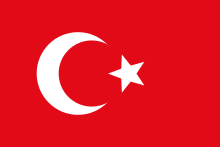
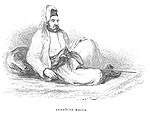
| Emir | Reign | Notes |
|---|---|---|
| Barakat II bin Muhammed | 1473–1525 | Co-reigned with his son Abu Numayy II for the last thirteen years of his rule; first Ottoman Sharif; Hejaz became an Ottoman state after the fall of Cairo to Sultan Selim I. |
| Abu Numayy II bin Barakat | 1512–1584 | Co-reigned with his father Barakat II for the first thirteen years of his rule, and with his son Hassan for the last thirty-one years of his rule; rebuilt the walls of Jeddah in 1525 following the victory over the Portuguese in the Red Sea. |
| Hassan bin Abu Numayy II | 1553–1601 | Co-reigned with his father for the first thirty-one years of his rule. |
| Abd al-Muttalib bin Hassan | 1601 | Reigned for less than a year. |
| Abu Talib bin Hassan | 1601–1603 | Co-reigned with his brother Idris. |
| Idris bin Hassan | 1601–1620 | Co-reigned with his brother Abu Talib for the first two years of his rule, then with his brother Fuhaid for six years and nephew Muhsin for sixteen. |
| Fuhaid bin Hassan | 1604–1610 | Co-reigned with his brother Idris and his son Muhsin. |
| Muhsin bin Fuhaid | 1604–1628 | Co-reigned with his father for the first six years of his rule, and with his uncle Idris for the first sixteen. |
| Ahmed bin Abd al-Muttalib | 1628–1629 | |
| Masoud bin Idris | 1629–1630 | |
| Abdullah I bin Hassan | 1630–1631 | |
| Muhammed bin Abdullah | 1631–1632 | Co-reigned with his first cousin once removed, Zeid. |
| Zeid bin Muhsin | 1631–1632 | First reign, co-reigned with his first cousin once removed, Muhammed. |
| Namy bin Abd al-Muttalib | 1632 | Briefly co-reigned with his cousin Abd al-Aziz. |
| Abd al-Aziz bin Idris | 1632 | Briefly co-reigned with his cousin Namy. |
| Zeid bin Muhsin | 1632–1666 | Second reign. |
| Saad bin Zeid | 1666–1672 | First reign, co-reigned with his brother Ahmed for the last three years of his rule. |
| Ahmed bin Zeid | 1669–1672 | First reign, co-reigned with his brother Saad. |
| Barakat bin Muhammed bin Ibrahim bin Barakat bin Abu Numayy | 1672–1682 | |
| Said bin Barakat | 1682–1683 | |
| Ahmed bin Zeid | 1672–1688 | |
| Ahmed bin Ghalib bin Muhammed bin Musaid bin Masoud bin Hasan | 1688–1690 | |
| Muhsin bin Hussein | 1690–1691 | |
| Said bin Saad | 1691 | Ceded reign to his father Saad. |
| Saad bin Zeid | 1691–1696 | Second reign. |
| Abdullah II bin Hashim | 1696 | Co-reigned with Said. |
| Saad bin Zeid | 1694–1702 | Third reign. |
| Abdulkarim bin Muhammed | 1704–1705 | First reign. |
| Saad bin Zeid | 1705 | Fourth reign, lasted eighteen days. |
| Said bin Saad | 1705 | |
| Abdulkarim bin Muhammed | 1705–1711 | Second reign. |
| Said bin Saad | 1711–1717 | Second reign. |
| Abdullah III bin Said | 1717–1718 | First reign. |
| Ali bin Said | 1718 | |
| Yahya bin Barakat | 1718–1720 | |
| Mubarak bin Ahmad | 1720–1723 | |
| Yahya bin Barakat | 1723–1725 | |
| Abdullah III bin Said | 1725–1731 | Second reign. |
| Muhammed bin Abdullah | 1731–1733 | Co-reigned with his uncle Masoud for the last year of his rule. |
| Masoud bin Said | 1732–1752 | Briefly co-reigned with his nephew Muhammed for the first year of his rule. |
| Musaid bin Said | 1752–1759 | First reign. |
| Jafar bin Said | 1759–1760 | |
| Musaid bin Said | 1760–1770 | Second reign. |
| Abdullah IV bin Hussein bin Barakat | 1770–1771 | |
| Ahmed bin Said | 1771–1773 | |
| Surur bin Musaid | 1773–1788 | |
| Abd al-Muin bin Musaid | 1788 | First reign, only lasted a few days. |
| Ghalib bin Musaid | 1788–1813 | Co-reigned with his brother Abd al-Muin while Saudis held the city of Mecca. |
| Abd al-Muin bin Musaid | 1796–1813 | Second reign, co-reigned with his brother Ghalib. |
| Yahya bin Surur | 1813–1827 | |
| Abd al-Muttalib bin Ghalib | 1827 | First reign. |
| Muhammed bin Abd al-Muin bin Awn bin Muhsin bin Abdullah bin al-Hussain bin Abdullah I | 1827–1851 | First reign, placed in power by Muhammad Ali Pasha. |
| Abd al-Muttalib bin Ghalib | 1851–1856 | Second reign. |
| Muhammed bin Abd al-Muin | 1856–1858 | Second reign. |
| Abdullah bin Muhammed | 1858–1877 | |
| Hussein bin Muhammed | 1877–1880 | |
| Abd al-Muttalib bin Ghalib | 1880–1881 | Third reign. |
| Abd al-Ilah bin Muhammed | 1881–1882 | Was appointed again in 1908 after the deposition of Ali bin Abdullah, however he died before reaching Mecca. |
| Awn ar-Rafiq bin Muhammed | 1882–1905 | |
| Ali bin Abdullah bin Muhammed | 1905–1908 | |
| Hussein bin Ali Pasha | 1908–1916 | Later King Hussein |
| Ali Haidar Pasha | 1916–1917 |
During the Kingdom of Hejaz (1916–1925)

| Portrait | Monarch | Reign | Notes | Prime Minister |
|---|---|---|---|---|
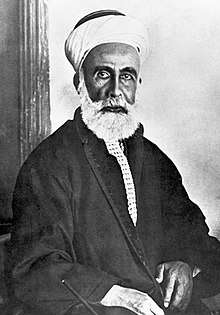 |
King Hussein bin Ali | 1916–1924 | Previously Hussein Pasha | Ali bin Hussein (1916–1924) |
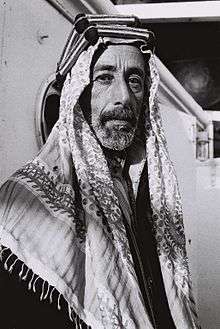 |
King Ali bin Hussein | 1924–1925 | Invaded by Nejd on 19 December 1925 | Abd Allah Siraj (1924–1925) |
| Muhammad at-Tawil (1925) |
See also
- Custodian of the Two Holy Mosques
- Sharifate of Mecca
- Hejaz Vilayet
- Kingdom of Hejaz
- Sharifian Caliphate
- Battle of Mecca (1916)
- Battle of Mecca (1924)
- Siege of Medina
- List of Caliphs
- List of Sunni Muslim dynasties
References
- "شريف مكة - ويكيبيديا، الموسوعة الحرة". Retrieved 2017-03-17.
- "الأشراف الهواشم الأمراء - أشراف الحجاز". www.al-amir.info (in Arabic). Retrieved 2017-03-17.
- "Ibn Saud reign of Hejaz – www.saudinf.com".
- al-Sinjārī, Manā’iḥ al-karam, 2/311–314
- al-Sinjārī, Manā’iḥ al-karam, 2/312–314; al-‘Izz Ibn Fahd, Ghāyat al-marām, 2/39–40
- al-Sinjārī, Manā’iḥ al-karam, 2/314–315
- al-Sinjārī, Manā’iḥ al-karam, 2/315–316
- al-Sinjārī, Manā’iḥ al-karam, 2/315–316
- al-Sinjārī, Manā’iḥ al-karam, 2/316; al-‘Izz Ibn Fahd, Ghāyat al-marām, 1/642, 2/10; al-Najm Ibn Fahd, Itḥāf al-wará, 3/76
- al-Sinjārī, Manā’iḥ al-karam, 2/316–317; al-‘Izz Ibn Fahd, Ghāyat al-marām, 1/642, 2/10–12, 44–46; al-Najm Ibn Fahd, Itḥāf al-wará, 3/76–77
- al-Sinjārī, Manā’iḥ al-karam, 2/317–318; al-‘Izz Ibn Fahd, Ghāyat al-marām, 1/640–642, 2/11–12
- al-Sinjārī, Manā’iḥ al-karam, 2/318; al-Najm Ibn Fahd, Itḥāf al-wará, 3/80
- al-Sinjārī, Manā’iḥ al-karam, 2/319–321; al-‘Izz Ibn Fahd, Ghāyat al-marām, 1/641–642, 2/12–14; al-Najm Ibn Fahd, Itḥāf al-wará, 3/93–99
- al-Sinjārī, Manā’iḥ al-karam, 2/321–322; al-‘Izz Ibn Fahd, Ghāyat al-marām, 2/14–16; al-Najm Ibn Fahd, Itḥāf al-wará, 3/101
- al-Sinjārī, Manā’iḥ al-karam, 2/323–324; al-‘Izz Ibn Fahd, Ghāyat al-marām, 2/17–18; al-Najm Ibn Fahd, Itḥāf al-wará, 3/118–119
- al-Sinjārī, Manā’iḥ al-karam, 2/324–325; al-‘Izz Ibn Fahd, Ghāyat al-marām, 2/38; al-Najm Ibn Fahd, Itḥāf al-wará, 3/132–134
- Stitt, George (1948). A Prince of Arabia, the Amir Shereef Ali Haider. George Allen & Unwin, London.
- Bosworth, Clifford Edmund (1996). The New Islamic Dynasties. Edinburgh University Press.
- Antonius, George (1946). The Arab Awakening. Capricorn Books, New York.
- The Hashemites, 1827-present
Bibliography
- Mortel, Richard T. (1985). "The Genealogy of the Ḥasanid Sharifs of Mecca". Journal of the College of Arts, King Saud University. 12: 221–250.CS1 maint: ref=harv (link)
- Mortel, Richard T. (1987). "Zaydi Shiism and the Hasanid Sharifs of Mecca". International Journal of Middle East Studies. 19 (4): 455–472. JSTOR 163211.CS1 maint: ref=harv (link)
- Ibn Fahd, ‘Izz al-Din ‘Abd al-‘Azīz ibn ‘Umar (1986–1988) [Composed before 1518]. Shaltūt, Fahīm Muḥammad (ed.). Ghāyat al-marām bi-akhbār salṭanat al-Balad al-Ḥarām غاية المرام بأخبار سلطنة البلد الحرام (in Arabic) (1st ed.). Makkah: Jāmi‘at Umm al-Qurá, Markaz al-Baḥth al-‘Ilmī wa-Iḥyā’ al-Turāth al-Islāmī, Kullīyat al-Sharīʻah wa-al-Dirāsāt al-Islāmīyah.
- Ibn Fahd, Najm al-Din Umar ibn Muḥammad (1983–1984) [Composed before 1481]. Shaltūt, Fahīm Muḥammad (ed.). Itḥāf al-wará bi-akhbār Umm al-Qurá إتحاف الورى بأخبار أم القرى (in Arabic) (1st ed.). Makkah: Jāmi‘at Umm al-Qurá, Markaz al-Baḥth al-‘Ilmī wa-Iḥyā’ al-Turāth al-Islāmī, Kullīyat al-Sharīʻah wa-al-Dirāsāt al-Islāmīyah.
- al-Sinjārī, ‘Alī ibn Tāj al-Dīn ibn Taqī al-Dīn (1998) [Composed 1713]. al-Miṣrī, Jamīl ‘Abd Allāh Muḥammad (ed.). Manā’iḥ al-karam fī akhbār Makkah wa-al-Bayt wa-wulāt al-Ḥaram منائح الكرم في أخبار مكة والبيت وولاة الحرم (in Arabic) (1st ed.). Makkah: Jāmi‘at Umm al-Qurá.